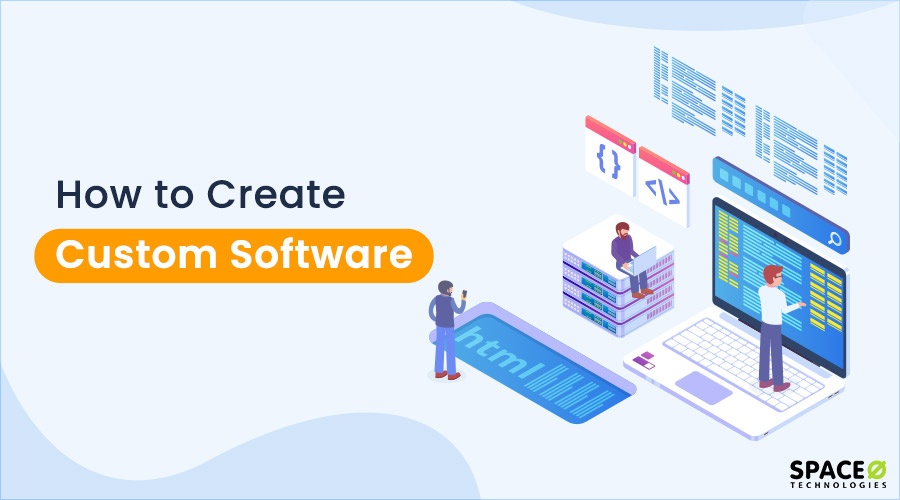We understand your business is very close to your heart, and facing business-related challenges might be stressful for you at times. The situation becomes even worse when your challenges can’t be addressed with off-the-shelf software.
Looking at your business-specific challenges, if you have decided to create custom software for business, you have taken the right step. A report by Statista states that the global market revenue of enterprise software is valued at USD 294.30 billion in 2024 and is projected to reach USD 400.40 billion by 2029. This indicates that more and more enterprise-level businesses are realizing the potential of business software and are quick to adopt and modernize. This statistic is enough to validate your decision.
Look at Amazon, one of the biggest e-commerce businesses that use custom software (with Artificial Intelligence) to collect data on customers’ product preferences. The algorithm of custom software understands what customers actually need and creates a better online buying experience for everyone.
In the same way, if you have a small, medium, or large enterprise business, creating custom software applications will ensure your business thrives. So, let’s get started to know how to create custom software for your business.
Table of Contents
What is Custom Software Development?
Custom software development means the designing of software applications to address the challenges faced by users within an enterprise business. Custom software development services address the users’ needs better than off-the-shelf software or readymade software.
For example, Microsoft Office or Adobe Photoshop, which are specifically designed to address the challenges of the diverse needs of software users. Inevitably, you cannot modify or update the functionalities of these software solutions according to your needs.
On the other hand, customized software development services need a detailed plan and is created by a software development team or in-house software developers. The custom software development process includes:
- Designing
- Developing
- Deploying
- Maintaining Software
A custom software solution is developed keeping the company’s management, branding, implementation needs, and business processes in mind. Look at McDonald’s, it uses POV technology to serve millions of customers with their customized orders.
Before you finalize the software development plan, let’s discuss the steps to custom software development for your business in the next section.
Step-by-Step Guide to Create Custom Software
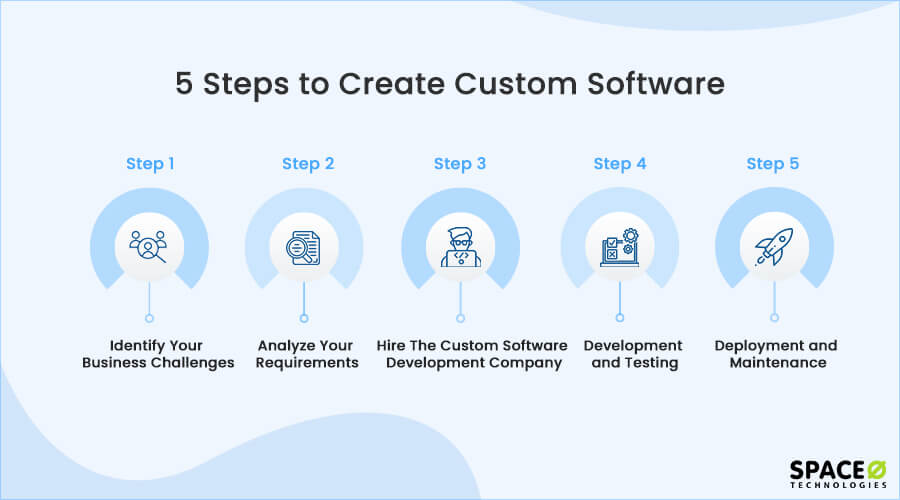
Whether you are an entrepreneur or planning software development for a small business, follow these 5 points and get a clear answer to how to develop custom software. So, let’s dive deeper and understand each step in a very simple manner.
Identify Your Business Challenges
- Managing a large number of employees
- Increasing work efficiency
- Boosting business revenue
Analyze Your Requirements
- Customer relationship management (CRM)
- Accounting and financing
- Task scheduler system
- Security
- Integration with existing systems
- Migration from off-the-shelf software to new software
- Work automation
Hire a Custom Software Development Company
- Saves time
- Minimize risks of software development projects
- Makes scaling easier
- The larger labor pool of talented professionals
- Access to multiple services
Software Development and Testing
- Unit testing
- Component testing
- Smoke testing
- Sanity testing
- Regression testing
- Integration testing
- API testing
- UI testing
- Availability testing
- Performance testing
- Compatibility testing
- Localization testing
- Volume testing
- Scalability testing
- Usability testing
- Reliability testing
- The core application functions
- Text input
- Installation on localized machines
- Security of the software
Software Deployment and Maintenance
How to develop software? When you have this question, first you need to identify core business challenges. We all know that every business has its own unique work process and business needs. One specific software can never fulfill the requirements of each business.
Therefore, you need a custom or tailor-made solution to solve your entire business-related challenges, such as:
So, when you start to develop custom software development for small businesses, identify your business challenges first that you are concerned about the most. Discuss your challenges and requirements thoroughly with your management team, business leaders, and employees.
After this discovery phase about your challenges, it is time for you to analyze the requirements that can help you minimize the difficulties.
Once you have a list of all your challenges, focus on the features and functionalities that you want to integrate into the software solution. Make sure you only add those advanced features that would help you to streamline your business process in the long run.
So, analyze what you actually need and what can be helpful for you to streamline the business. Let’s take an example to understand this step in a better way. Suppose you run an on-demand business and are facing challenges to manage customers’ data or probably looking to generate new leads.
In fact, according to a study, it is found that without CRM, 79% of marketing leads never convert into sales. We are sure that you wouldn’t let this happen to your business. And just like you, no other entrepreneur would be ready to lose their marketing leads.
Therefore, we have also shared some of the advanced and common features that you can consider for your custom software application. Here are the key features:
Once you decide on all the features and functionalities for your software, create software architecture design.
There is a pool of top software development companies in the custom software development market. Therefore, it becomes extremely difficult to choose a development company that understands your requirements and offers you the exact same results you need.
In fact, many enterprise businesses prefer working with top software development outsourcing companies. As per a report by Verified Market Research, the global software development outsourcing market is expected to reach USD 897.7 billion by 2031, exhibiting a CAGR of 5.49% between 2024 and 2031. Also, here are some of the benefits of outsourcing to a custom software development company.
Look at the following image to know the 3 steps of outsourcing to a software development company.
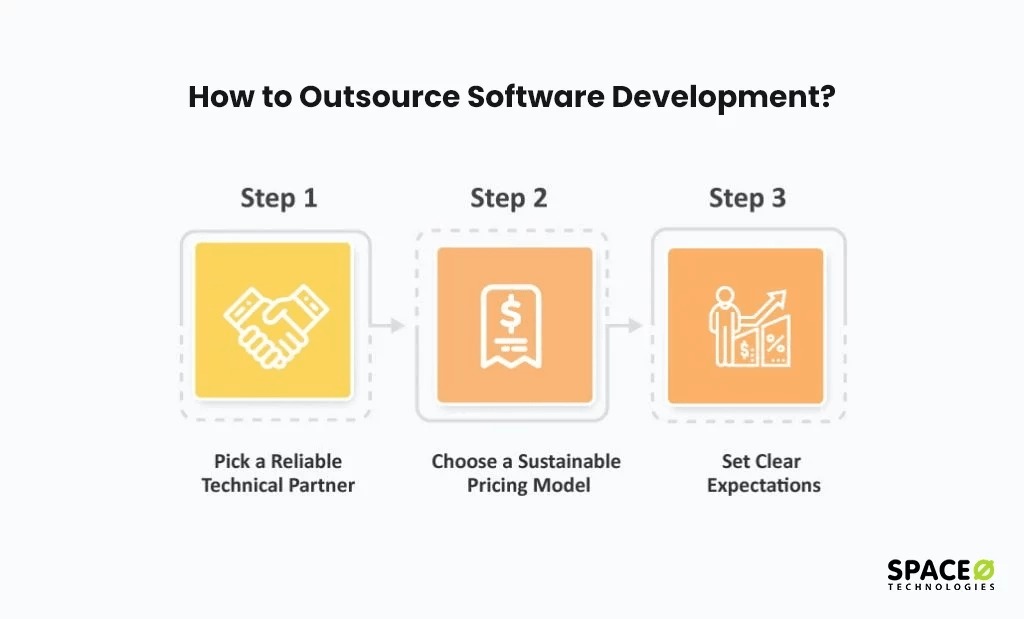
When it comes to a reliable technical partner, we can assure you that Space-O Technologies has always been an ideal choice for entrepreneurs. We believe in providing the best software solutions to your complex business needs. We truly understand your requirements and deliver the best custom software services without compromising their quality.
In fact, we are ranked amongst the top software development companies on GoodFirms and Upwork. We have 100% job success on Upwork with more than 950+ jobs done.
We are also sharing a checklist that will help you while choosing an outsourcing company. You can consider any of the preferred factors to select the best software company.
We will now move ahead to the next step, where we will discuss the development of custom software and testing parts of the software.
Now you have decided on the bespoke software development company as per your preference, you can start the software development process by signing an NDA (non-disclosure agreement). To keep your proprietary information and idea safe, signing an NDA is essential.
Also, know that this step is the longest one where you will need to invest your time to build custom software solution. Being an owner of the business, you will need to ensure that everything is in line and that the custom software development for enterprise processes is going smoothly.
For this, you can regularly contact the project managers or get in touch with the dedicated development team. Also, know that when all the components such as system requirements, the architecture, and the wireframe are in line, the plan execution would be a lot easier and faster.
Once your customized software application is ready, the software development team will carry out the testing phase. This phase will also involve various types of functional and non-functional testing. This is either achieved manually or automatically.
| Functional Testing | Non-functional Testing |
|---|---|
Apart from this list, it is essential to test the software for:
In case any bug or error is detected, it will be fixed and re-tested. The whole testing process will continue until the quality of your software matches the original requirements. The software development team will ensure that everything is smooth and the customized application software is offering you the same results that were expected.
After successful testing, your software will be ready to get launched.
This time, you and your users will start getting familiar with the system. You all will start using the software. Therefore, you need to note that the development company will support the software application post-release as well.
You can choose to install the software in your existing system. Later, under the guidance of the development company, end-users will be trained for using the software. Gradually, your team will learn to operate the software, and the integration of software with existing systems can be implemented.
In case your software needs maintenance or up-gradation, you can contact the development company. However, you need to talk to the software development company beforehand about whether they will offer the maintenance services or not. This will streamline the whole software development process and avoid you paying maintenance costs.
After discussing these 5 steps, you know how to create a software program from scratch, and it is now clear how you can start the whole software development process.
Want to Validate Your Custom Software Idea?
Want to discuss this with our technical experts? Want to get a free consultation?

Now, we will discuss the important methodologies, which are used to design and develop the custom software solution.
5 Best Custom Software Development Methodologies
What is custom software development methodology?
The methodology is a sequence that is used in a custom software development project. In other words, it is a kind of framework where plan, design, and control the development process. Development methodologies include standard processes like:
- Design
- Development
- Implementation
Choosing the right methodology is always essential when you start to develop a custom solution While there are several standard processes like design, development, and implementation, it is important to understand the differences between software development vs app development methodologies.
The style of development and the system you choose has an impact on the success of the project. However, it largely depends on the team size, organization, and product goals. A properly defined methodology offers you with:
- Better estimates
- Delivering stable systems
- Keeping the customer informed
- Creating a clear understanding of the task ahead
- Identifying pitfalls earlier
- Allowing for ample time to make adjustments
The primary and competitive advantage of choosing the right methodology is to have a smooth and effective software development process. However, each methodology comes with a unique set of features, advantages, and disadvantages.
We have discussed 5 essential methodologies below.
- Waterfall Methodology
- Agile Methodology
- Spiral Model Methodology
- Scrum Development Methodology
- Big Bang Methodology
After reading and knowing about custom software development, you will easily be able to choose the perfect methodology for your project.
Waterfall Methodology
- Requirement specification
- Software designing
- Integration to existing software or creating a new process
- QA/Testing
- Deployment
- Maintenance
- The requirements are known, clear, and fixed
- No confusion with the end goals
- The project is short
- The risk is minimum or zero
- Easy to manage projects because of rigidity
- Best for small enterprises
- Stages are well-defined
- Arrange tasks easily
- The timeline is determined precisely
- Deployment is only possible in the last stage
- Not recommended for complex projects
- Measuring the progress is not possible
- The documentation process takes a lot of time
Agile Methodology
- Want regular changes in your software
- Have limited planning to get started with the project
- Want to produce more features in a shorter period of time
- Provide two-way communication between client and vendor
- The process is divided into several parts to manage custom development
- Rapid and continuous delivery of software
- No proper documentation
- Needs precise requirements for the outcome
- Requires a highly experienced team
- No definite structure
Spiral Model Methodology
- Want to build large, expensive, and complicated projects
- To reduce and manage the risk of the project
- When the budget is limited, and risk evaluation is important
- Flexibility to change the flow of the process whenever required
- Risks can be eliminated at the early stage
- Recommended for large size and complex projects
- Symmetrical addition of features is possible
- The development process is divided into smaller parts
- Success of your project is dependent on risk analysis
- Continuous implementation can stretch the project deadline
- Lengthy documentation because of multiple phases
- Management is complex
Scrum Development Methodology
- Planning
- Meeting
- Conclusion
- Project requirements are well-understood at the beginning
- Requirements frequently change according to your needs
- To achieve quick turnaround (2 – 4 week) for high-priority
- The decision-making responsibility is on the development team
- Project development can be tracked to get frequent updates
- Feedback makes the process easier
- Need accurate time and cost estimation
- Not recommended for complex and long-term projects
- Regression testing is required for each phase
Big Bang Methodology
- Ideal for small projects with one or two developers
- Requirements are not clear, and there is no deadline
- When you don’t have any planning to go ahead with the process
- If you are changing your requirements too quickly
- Doesn’t need proactive planning
- Only minimal resources are required
- Very easy to manage
- Suitable for beginners, learners, and students
- Has high risks and uncertainty
- Not suitable for complex projects
- Not for long-term or ongoing projects
- Chances of the project getting scrapped
The waterfall model is known as a linear sequential life cycle model, and it is also considered a software development life cycle approach. The waterfall model is one of the oldest and most popular methodologies that you can use for your project.
As its name defines, the waterfall method follows a sequential flow and doesn’t overlap the custom software development progress. We have also explained the same through the following image.
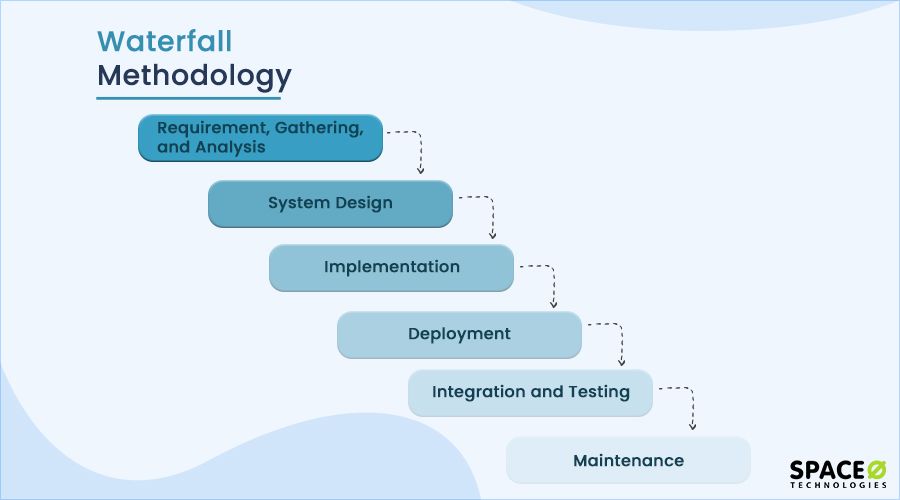
The sequential flow ensures that it is easy to follow and has a functional flow. You can save money and time because everything is well-planned and structured. The waterfall methodology works flawlessly like a waterfall and has a defined set of phases, such as:
Departments like defense, military, and aircraft follow the waterfall model because of the strict standards and natural flow. The waterfall model is compatible with their acquisition process and makes it easy to follow the process required by the government.
Conditions When Waterfall Methodology is Suitable
Advantages and Disadvantages of Waterfall Methodology
| Pros | Cons |
|---|---|
Agile is an advanced version of the waterfall as it is developed in response to the challenges of the waterfall. Agile is more flexible as compared to waterfall. It starts with the simple design of projects, where you can assign each module a completion target.
After the successful completion of each module, you can evaluate the work process and give your feedback. Later, all the bugs are fixed and code quality is monitored.
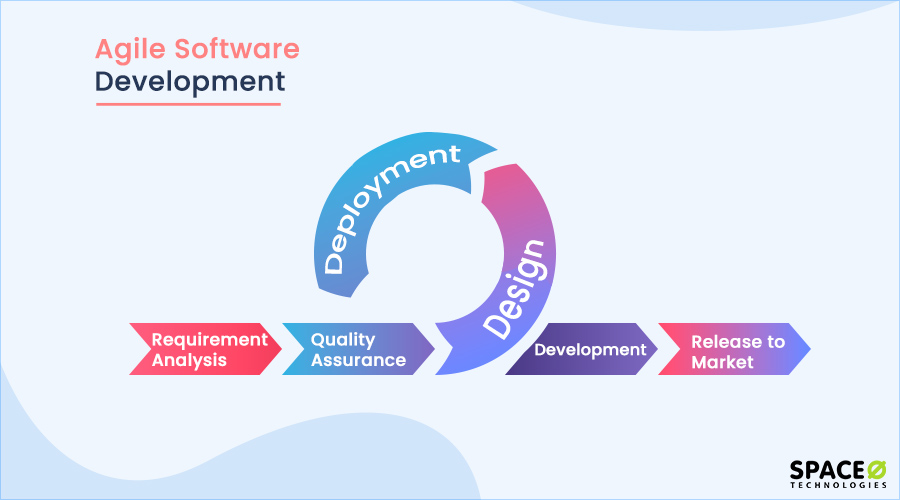
The best part of using agile is that software developers are allowed to make continuous changes according to their project requirements. This way, the developer can always look back to the previous phase and rectify the error.
The agile method offers a bifurcation system that uses a successive iterative approach. This means, all the phases can be bifurcated into smaller parts, such as testing, validation, integration, and deployment.
Many well-known organizations are currently using an agile method for their custom software to deliver results in a fast, experimental, and iterative manner, such as Apple, IBM, Microsoft, and Procter & Gamble.
Conditions When Agile Methodology is Suitable
Advantages and Disadvantages of Agile Methodology
| Pros | Cons |
|---|---|
Just as the name suggests, the spiral model starts with the smaller section of the software development and moves towards the larger sections. To carry out the systemic flow, many app development companies use the spiral model methodology.
The prime reason for using the spiral model is that it identifies and eliminates risks at an initial stage itself. Everything is systemized in this model, so it becomes really easy to streamline the development process.
Conditions When Spiral Model Methodology is Suitable
Advantages and Disadvantages of Spiral Model Methodology
| Pros | Cons |
|---|---|
Scrum methodology divides your project into different smaller groups, and each phase is carried out with a unique strategy. To custom build software faster and to see rapid transformations, scrum is highly recommended as it allows a series of iterations in a single go.
Scrum has three sequential phases:
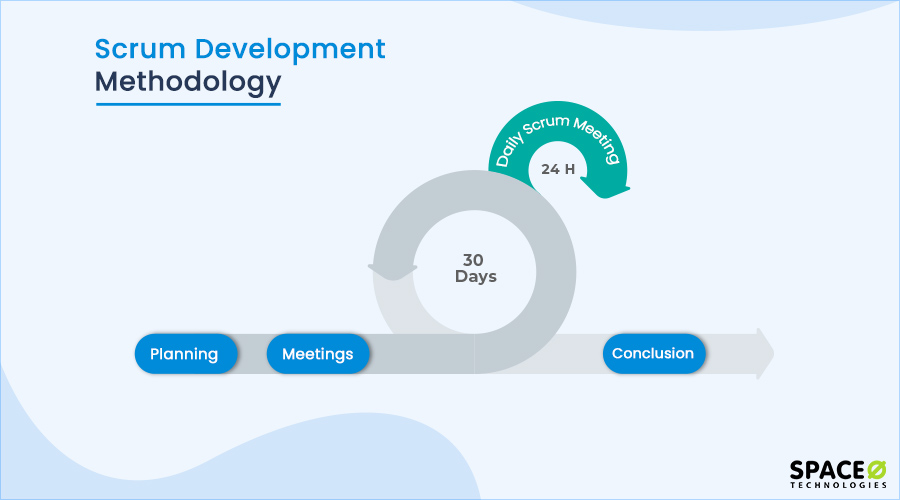
With scrum, you start the project with short planning, and then a detailed analysis of the project is carried out. Later, the development process is implemented. For scrum, you need a team of cross-functional engineers, who have experience in analyzing requirements, designing, coding, testing, and installation.
According to the 12th Annual State of Agile report, 70% of enterprise businesses use the scrum method. This includes industries like financial services, product development, construction, and consulting firms.
Conditions When Scrum Development Methodology is Suitable
Advantages and Disadvantages of Scrum Development Methodology
| Pros | Cons |
|---|---|
The big bang methodology is the best method for entrepreneurs who aren’t aware of the requirements and do not have a proper vision for the outcomes. Therefore, it is best recommended for small and simple projects. It is not complicated or has rigid formal protocols.
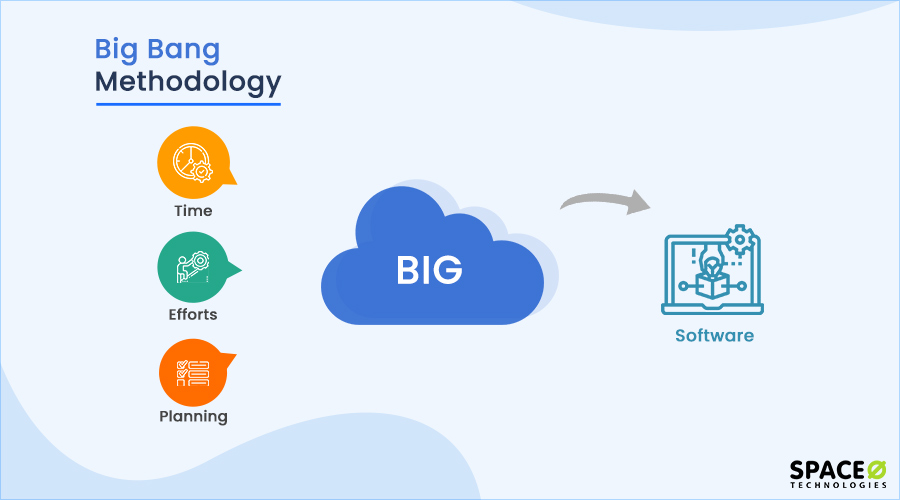
It will not require pre-hand planning for your project. You can manage it easily as the resources required are very minimal. However, it can be a risky model if you are planning to use it for complex or big projects.
Conditions When Big Bang Methodology is Suitable
Advantages and Disadvantages of Big Bang Methodology
| Pros | Cons |
|---|---|
After discussing the important methodologies, we will check for the reasons why a custom solution is essential for your business.
Want to Develop a Custom Software for Your Enterprise Business?
Our experienced developers have built various customized solutions for clients using advanced technologies, such as Machine Learning and Artificial Intelligence.
Why is Custom Software Development Required?
Being an entrepreneur, there must be several unique business goals that you wish to achieve. However, the readymade or off-the-shelf solution doesn’t come with all the features that you need for your unique business requirements.
In fact, with the constant changes and latest technology trends, market demands are also changing. This means you cannot really rely on just an off-the-shelf solution. In such situations, it becomes extremely important to go ahead with custom solutions for achieving business goals. But, wait. What is the difference between custom solutions and ready-made software?
This table will give you a better idea to understand both types of custom software.
| Custom Solution | Off-the-shelf Solutions |
|---|---|
|
|
|
|
|
|
|
|
|
|
|
The custom solution includes your business needs and the required features and tools. It is certainly one of the best and most reliable solutions to upgrade software according to your business needs. Now, let’s see how a custom solution can benefit your business needs.
| Benefit | Description |
|---|---|
| Better Integration |
|
| Addresses Business Needs |
|
| Reduce Cost & Increase Performance |
|
| Business Security and Safety |
|
| Help You Focus on Core Business Areas |
|
If you are still looking for the answers to questions like what is the cost to develop a custom software solution and the types of customized software solutions, then check the next FAQ section.
FAQs About Custom Software
What is custom software with examples?
Custom software is specially developed to fulfill the unique requirements of a user or an organization. It is developed keeping the customers’ demands and specific requirements in mind. Here are some of the top companies which are using custom solutions to thrive in their respective industries:
- BlackBerry – Issue Tracking Application
- Monster Movers – GPA Tracker Application
- Life Support Systems – Performance Tracking App
How much does custom software development cost?
The cost of developing a simple business software with basic functionalities ranges from USD 28,000 to USD 140,000. The development costs for complex software with advanced features and integrations can be higher, ranging between USD 160,000 and USD 350,000.
However, these are generic estimates and your software’s cost may vary based on features, tech stack, and developer rates. You can consult with our experts to get a quote for your software project.
What are the types of customized software?
- Content Management Systems (CMS)
- Customer Relationship Management (CRM)
- Enterprise Resource Planning Software
- Operations Management Software
- Enterprise Software Solutions
What are the examples of custom made bespoke software?
- Streamling services
- Video streaming services
- Voice recognition services
- Custom software for banking
- Delivery service software
What is system software examples?”
System software serves as a foundation for other software. Operating systems such as macOS, Linux, Android, and Microsoft Windows are examples of the system software. Also the computational scientific software, game engines, search engines, industrial automation, and software as a service application are considered a system software
Want to Build Your Own Custom Software Solution?
Through this blog, we have learned the essential steps to create custom software for your unique business needs. In fact, we have also discussed the 5 best methodologies that you can use to build your own custom solution. These methodologies are unique and have a set of unique features, so ensure you choose the methodology that suits best to your requirements.
In case you have other questions on building custom software or want to develop a custom solution for your business requirements, get in touch with our experienced software developers. We have developed several customized solutions for our clients, from small enterprises to large enterprises. Let’s have a look at some of the best mobile apps that we have developed for our clients:
- MedCall: Doctor on-demand app solution
- NetQuote: An iPad application to generate an instant quote
You can contact us through the ‘Contact Us’ page and one of our sales representatives will get back to you shortly.
